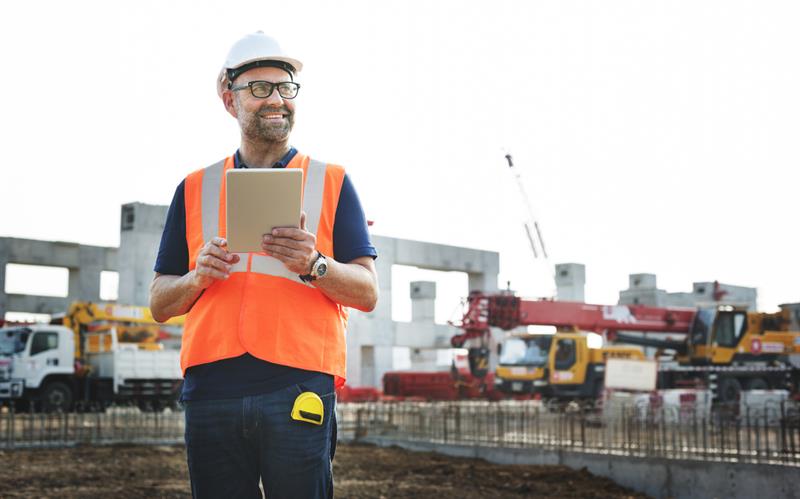Yet, despite these challenges, the industry has been somewhat slow at adapting to and implementing new technologies. However, with growing labour shortages, supply chain disruption and stricter regulations, it is having to innovate more and the use of technology is seen by many as a key priority for the sector as it looks to become more resilient.
“The key challenges are centred on increasing productivity and performance,” said Drew Morris, Sales Director, Comms365, a communications specialist. “Technology needs to be at the heart of this transformation as we look to accelerate innovation and support new processes in order to create high performing systems that work more effectively together.”
Today technology is more consistently being used at construction sites and has certainly helped to enhance the efficiency of the building process.
Artificial intelligence (AI) is being used to improve the effectiveness of building designs and has been found to reduce build time by up to 30%; drones are being deployed to analyse building sites and to identify dangerous areas and enabling the safety of sites to be improved. Robots are also finding a use helping to increase the speed and quality of construction work, while virtual reality (VR) and augmented reality (AR) look set to revolutionise construction by providing 3D visualisations of designs and actual sites.
However, according to Morris, while rapid advances in technology and the advent of cloud-based services and applications means that the way the industry is working and collaborating is drastically changing the construction industry remains somewhat behind ‘the curve’.
“Technology innovation drives efficiency, productivity and cost effectiveness. Yet, when it comes to construction, investment in IT has remained low compared to other industries,” he suggested. “The market has been hampered by technical challenges relating to projects that can be large, complex and geographically dispersed. Combined with varying proficiency and maturity levels of smaller subcontractors, advancing at scale has been difficult and has subsequently led to the slow progress of digitisation.”

Despite this, according to Nick Sacke, Head of IoT solutions at Comm365, there is now growing evidence that the industry is embracing digitalisation.
“Today, larger companies are looking to digitalise their processes driven by increased levels of competition and the growing need for greater levels of co-operation between partners working on projects. The flow of information is accelerating and we’re seeing the digitalisation of sites, supply chains and data.”
“Digitalisation has tended to be driven by smaller, more agile companies. But while they may be the first to move, the bigger construction companies have the resources to explore technology in more detail, although they will have more to digitalise.”
Whether raising productivity or managing waste management more efficiently, technology is all about gathering data, making use of it, gaining insight and then applying it.
“Technology is used to streamline processes, to make better use of people and to cut costs, “ said Sacke, “and technology can address some of the big challenges that lie ahead for the industry. Whether that’s the upcoming Clean Air Act or working to reduce carbon emissions the industry is using technology to develop new processes to make them more efficient.”
The concepts of ‘green’ and sustainable construction are key drivers.
“If you look at concrete manufacturing it has an enormous carbon footprint so new materials are being introduced, that requires detailed monitoring and analysis,” said Sacke.
Today more concrete is used than any other substance, apart from water and, as a consequence, its manufacture produces 8% of the carbon dioxide (CO2) emitted into the atmosphere - substantially more than many other industries usually associated with pollution, such as aviation.
“New forms of concrete that produce significantly less carbon dioxide – up to 50per cent less – require sensor technology to monitor curing processes and the behaviour of new products,” said Sacke.
Technology is advancing rapidly and there are a growing number of examples as to how advances in digital technology can deliver efficiency and productivity opportunities.
“Drones, robotics, 3D printing and augmented reality are no longer concepts but are now being adopted by forward thinking firms looking to capitalise on the benefits that embracing innovation can bring to the construction site,” said Morris.
While the most widely adopted of all new technologies are mobile devices which allow workers to access, document, share and edit important project information, while industry-specific components such as barcode scanners and radio-frequency identification readers are used to track shipments, equipment and materials, Sacke sees the use of wearable technology as a significant ‘game-changer’ in the industry - improving conditions and enhancing health and safety.
“Wearable technology can be used to track people’s movements but it is also able to monitor where and how people are working and it has an important role in reducing the number of accidents. Not only can wearable technology track individuals, accelerometers can be used to flag up incidents, but the health monitoring of construction workers is now possible. That’s especially important where workers may be operating in hazardous conditions where air quality and environmental conditions need to be monitored.”
Unmanned aerial vehicles (UAVs), equipped with cameras have been in use for many years to collect information in locations that are hard for humans to access.
“Drones are increasingly being used to survey difficult areas which may have taken many hours to check using personal and traditional equipment. Drones can continually survey a location and give a holistic view of the site and the ‘lay of the land’,” explained Sacke. Captured images can be used to support site assessments and inspections, as well as augment a project team's understanding of how a project is progressing.
“Drones can monitor logistics, deliveries and the workforce. Some companies are taking drone footage and converting it into 3-D pictures that can be compared to architectural plans,” added Sacke. “Advanced cameras and lenses that can capture better images, as well as enhanced communication, in real-time, between drones and software are being developed.”
One of the great benefits of technology is that many separate construction activities can now be brought together, so the industry no longer has to operate in separate siloes. Technology is being used to monitor equipment usage, fuel usage and maintenance, and construction equipment manufacturers are now investing in more intelligent machines.

GPS hardware, for example, is being installed in vehicles enabling them to communicate with a "home base" via satellite and greater interconnectedness with other systems will mean that fleet tracking software and telematics systems will be able to provide instant data about field conditions, as well as equipment conditions, helping to improve operations.
While the adoption of new technology and smarter processes can deliver tangible benefits for construction firms, there remains a fundamental stumbling block for those organisations looking to capitalise on new innovation - the communications infrastructure.
“Finding the best connectivity to do the job is critical. Many companies face a frequent lack of high speed, portable and reliable Internet connectivity, particularly for sites located in green and brownfield locations, or having access to emergency communications should there be a delay in a fixed-line installation or accidental breakage to a line,” said Morris. “It is therefore imperative that the industry addresses these key issues as a matter of urgency so that firms can gain access to the connectivity they need at new sites.”
The catalyst of connectivity
“Technology that is crucial for the industry to innovate and keep up with demand, cannot function without high speed, portable and reliable internet connections,” explained Morris. “But as internet communications are no longer restricted to fixed-line only delivery companies can now invest in a blended communications model of wired and wireless internet access.”
Advanced bonded service solutions enable organisations to gain additional resilience and contingency from combining different internet access connections together into a single ‘virtual pipe’, with precise performance management. With combined bandwidth and enhanced reliable internet performance integrated into a portable solution, these types of service are suitable for rapid deployment emergency situations where internet services are required urgently and communications infrastructure is either missing or may take several weeks to be installed, meaning sites can be up and running in a matter of hours, not weeks.
“In addition, this approach builds in future-proofing by providing consistent bandwidth for improved performance and backup resilience to a primary connection for business continuity,” said Morris.
While it’s possible to use technology to improve project outcomes technologies need to work together synergistically and by bringing different processes together technology will help to improve the design and construction process. However, the implementation of technology must be part of a broader strategic platform.
According to the World Economic Forum, "Wherever new technologies have properly permeated this fragmented industry, the outlook is an almost 20 per cent reduction in total life cycle costs of a project, as well as substantial improvements in completion time, quality and safety."
Digital twins
The construction industry is also seeing the growing use of the ‘digital-twin’ concept to not only model designs more effectively, but to input ‘best practice’.
“It’s a dynamic process,” said Sacke, “and modelling enables you to adjust projects in near real-time. It makes it possible to access expertise from anywhere in the world and in turn this is leading to the greater use of AR and VR and the creation of a digital footprint that can be accessed in the future by city planners to help inform future construction projects.
“Building projects will be very different but there are common elements that will be transferable, and it’s important that we understand how data and best practice can be shared in the wider community – there are real commercial incentives when it comes to sharing data.”
According to Sacke this is where the IoT plays a critical role.
“The data that’s generated will be used on the construction site to assess real-time conditions, to improve construction activities ranging from supply chains to safety and can be used to shape business intelligence tools and enterprise resource planning systems.
“Edge computing, AI and data analytics make it possible to process data rapidly and alert sites to changing air quality, an increase in certain pollutants and energy usage in real-time, while ensuring security by monitoring access to the site.”
The construction industry needs to embrace digital advances and adopt smarter processes and technology to stay competitive and new technology will continue to disrupt the industry. Looking to the future technology like 5G promises a hyper connected environment and far more efficient processes.
“Technology and the digitalisation of construction is accelerating,” according to Sacke. “We’re seeing greater agility and the ability to adapt which is enabling the delivery of projects on time and to budget. Data collection and management will become routine – simply a matter of course – as the industry continues to evolve and change.”













